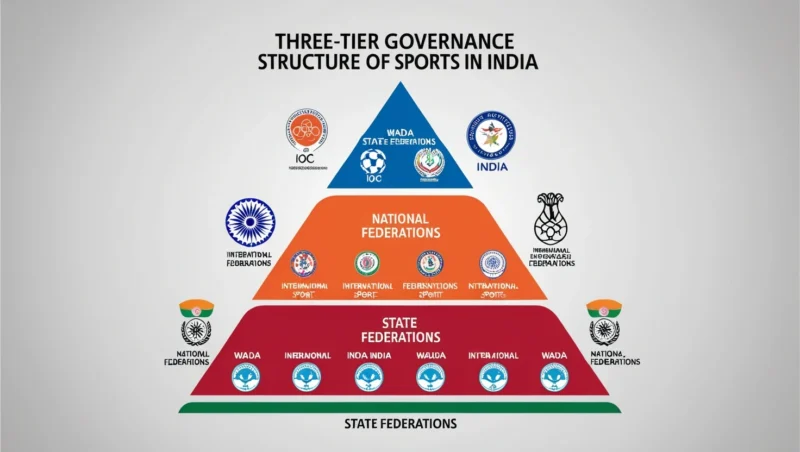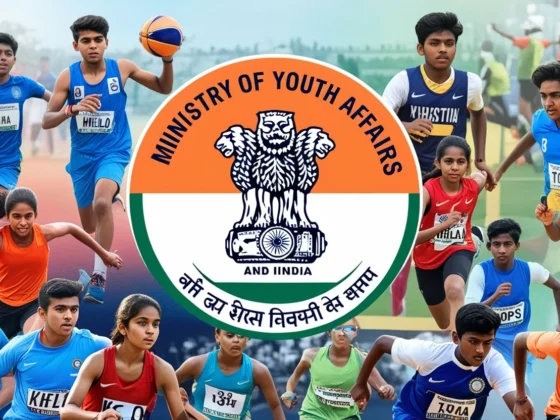In a country where sports play an increasingly vital role, national identity and international presence are significantly impacted. The governance of sports is a complex and layered process. India’s sports governance is structured in a hierarchical framework. This framework integrates international, national, and local institutions. This blog provides a deep dive into the structure of sports governing bodies in India. It also explores their interrelationships and the evolving role of the state. The blog discusses ensuring accountability and progress in the sports sector.
Understanding the Hierarchy of Sports Governing Bodies in India
The governance of sports follows a three-tier pyramid-like structure. At the apex are the International Federations (IFs), followed by National Federations (NFs). Finally, State and District Federations form the base. This structure ensures that the regulatory and ethical guidelines set globally trickle down. They effectively reach grassroots implementation.
International Federations govern particular sports across the globe. They establish rules and regulations that all member nations must follow. Each country recognizes one national federation per sport. This federation must adhere to the guidelines of the respective international body. At the state level, one federation oversees the sport in that state. It coordinates with local or district associations and clubs to manage the sport on the ground.
The National Sports Development Code, 2011: Guiding Indian Sports Governance
The National Sports Development Code of India, 2011 reinforces this hierarchical structure. It mandates clear roles and responsibilities for each layer of governance. The Code ensures accountability, transparency, and ethical conduct among sports bodies. It aims to maintain the integrity of the overall framework. The Code also guides how these bodies interact with the government. This is particularly concerning recognition, funding, and compliance.
The Role of Global Sports Institutions
India is a signatory to multiple global conventions. These conventions recognize the right to access sports as a fundamental aspect of human development. At the top of the international sports governance system is the United Nations (UN). Through its Office on Sport for Development and Peace (UNOSDP), it promotes the integration of sports into policy structures. This integration is for global peace and development.
Other critical international organizations include:
- International Olympic Committee (IOC): Governs the Olympic Movement and oversees the Olympic Games.
- World Anti-Doping Agency (WADA): Established in 1999 to lead global anti-doping efforts in sports.
- Court of Arbitration for Sport (CAS): Formed to resolve international sports-related disputes through a neutral and efficient legal process.
Ethics, Arbitration, and Legal Oversight
The legal framework around sports has evolved with the increasing number of international disputes. The CAS, based in Switzerland, became the authoritative legal body for resolving such conflicts. A role that was cemented through landmark rulings such as the Gundel Judgment. Its jurisdiction, once contested, is now widely recognized by courts globally.
WADA, through its globally accepted WADA Code, harmonizes anti-doping standards across all sports and countries. The National Anti-Doping Agency (NADA) facilitates India’s compliance with this code. This ensures fair play and ethical practices in sports.
The Role of the State and National Federations
In India, while sports governance ideally operates with limited state interference, the ground reality necessitates state involvement. Most sports, unlike cricket, do not generate sufficient revenue and require infrastructural and financial support from the government.
The Ministry of Youth Affairs and Sports (MYAS) plays a central role. It supervises approved federations, allocates funds, and implements schemes like Khelo India. Additionally, the Sports Authority of India (SAI) collaborates with various federations and bodies. This collaboration maintains training centers and promotes athlete development.
State governments, as sovereign entities, assist in the promotion of physical activities by financially supporting federations and grassroots initiatives. They enable the formation of district-level clubs and associations that fuel local participation and talent development.
Conclusion
The governance of sports in India is a multifaceted system that integrates international norms with national and local administration. Despite appearing straightforward, it is inherently complex, requiring coordination among diverse entities. The structure ensures that sports are promoted in an organized, ethical, and inclusive manner.
For India to emerge as a sporting superpower, it is essential that these governing bodies function transparently and efficiently. Continued legal reforms, capacity-building, and strategic state support play a crucial role in sustaining growth. These elements are vital for the integrity of the sector.
This Blog is written by Saumya Soni, advocate, Supreme Court of India.
For queries or collaborations, write to us at sportslegalorg@gmail.com

